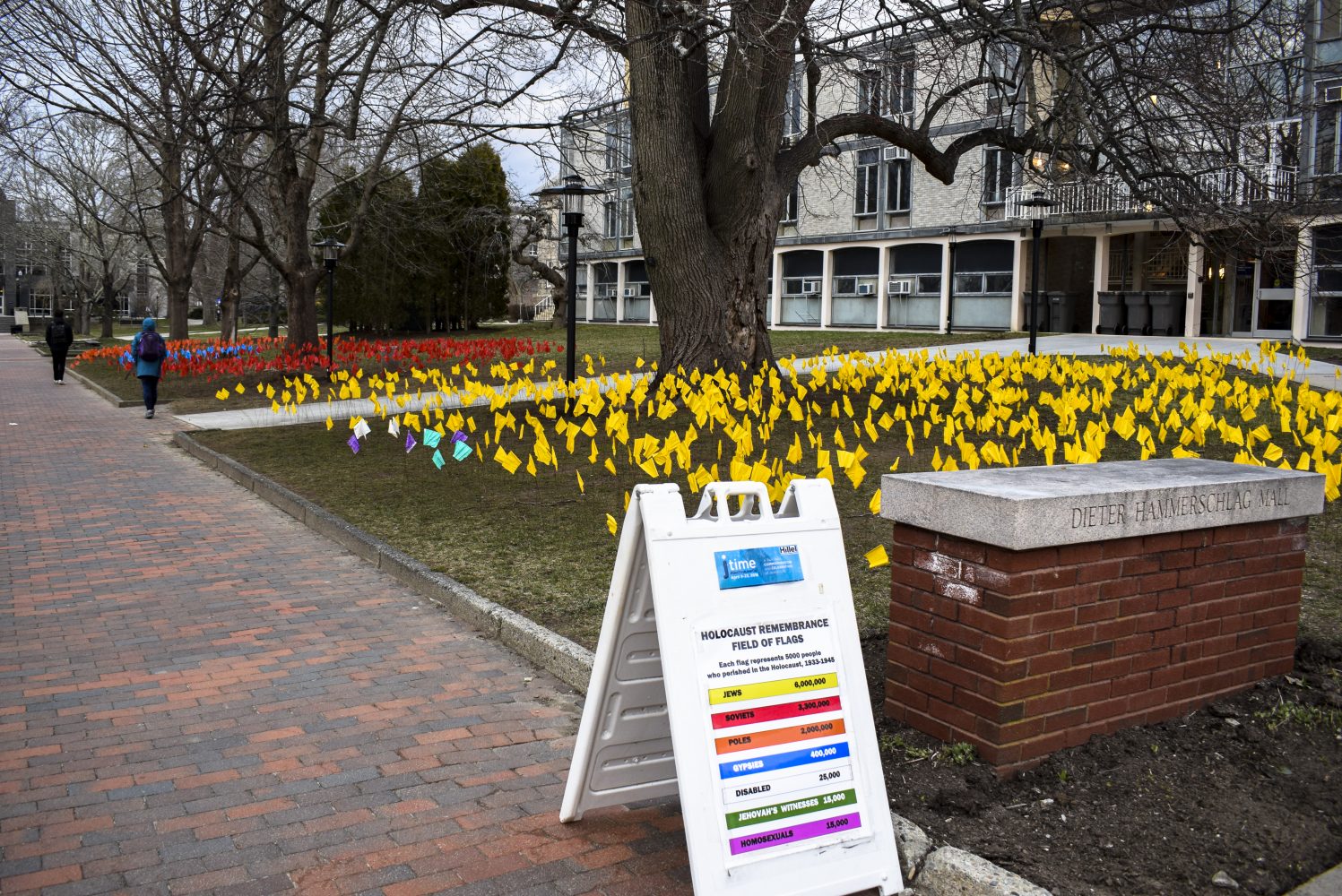Photo by Stephanie Erickson |CIGAR| The field of flags greeted students and URI community members as they walked to the library.
Students at the University of Rhode Island pass a sea of different colored flags alongside the area outside of Hammerschlag Mall each year, many not knowing the purpose behind them. Being the start of the first annual “J-time” commemoration this year, the flags serve as a visual reminder of the Holocaust’s catchphrase “Never Again.”
“One of the reasons that we find that this display is so effective is that it’s right there, and people walk by that part of the campus every day,” Amy Olson, executive director of the Hillel Center, said. “It catches their eye and even if they don’t stop to read the sign, they see it and it’s something that says, ‘oh, I wonder what this is.’”
Put together by Hillel, the “Field of Flags” consists of 2,400 flags planted in between the Multicultural Center and the library. Each flag represents 5,000 victims of the Holocaust, each with a different color representing a particular persecuted group. The flags were put up on April 9, the first day of J-time, by various volunteers of Hillel, Greek Life and student leaders.
“The tradition of the field of flags has been going on for about 11 or 12 years now,” Yaniv Havusha, director of Jewish student life at Hillel, said. “We take the flags out, put them out in the Hammerschlag Mall and have them on display. So it’s been an encompassing part of our Holocaust Remembrance Week that we’ve done traditionally.”
In total, the flags represent the over 11.7 million victims of the Holocaust. Of the total number victims, 6 million were Jewish, 3.3 million were citizens of the Soviet Union, 2 million were from Poland, 400 thousand were Gypsies, also known as Roma, 25 thousand were disabled, 15 thousand were Jehovah’s Witnesses and another 15 thousand were homosexuals.
According to Havusha, the colors of each flag were not picked at random, each has an association to a particular color. For example, Jews have a connection to the color yellow because in Nazi Germany they wear required yellow stars on them at all times. Soviets are the color red, Polish are orange, Gypsies are blue, the disabled are white, Jehovah’s Witnesses are green and homosexuals are purple.
“It’s like an art exhibit in some ways,” Olson said. “It’s an installation and we feel that it’s quite effective. Even the way the flags flutter in the wind, it serves as both an educational piece and also a memorial.”
Havusha and Olson both see the flags and J-time as a way to “expose the campus” to Jewish culture and promote the impact the Holocaust left on not only the persecuted communities but the human race. In previous years and so far this year, the two have seen a positive impact from the flags and look to continue the tradition throughout the years.
“As we get further and further away from the Holocaust, the memories are fading and survivors are fewer and far between,” Havusha said. “Anything we can do to bring that more to the forefront, or help the students remember and help others in the community I think is very important for us to do. And so we’re going to always continue to do that.”
Students such as freshman Jana Spiegel see the flags in a similar light once they learn the meaning behind them. In Spiegel’s case, whenever she sees the flags it reminds her about the famous poem by German anti-Nazi theologian Martin Niemöller, “First they came…”
“When I look at the flags… [they] make me remember that we all need to stand up for each other and what is right,” Spiegel said. “It is crucial to remember all the innocent lives taken and so history does not repeat.”
J-time is a two-week commemoration and celebration of Jewish life that Hillel is putting on for the first time this year. Part of J-time will include a celebration for Israel’s 70th Year of Independence on April 19 and a one-man show by professional comedian Joel Chasnoff on the 23rd. The flags were taken down the 18th, being on display for nine total days. Alongside J-time, Olson sees the flags as an opportunity for students, faculty and community members to learn from the mistakes of previous generations.
“It’s very important to keep talking about the errors of our past so we are not condemned to repeat them in the future, as the human race sometimes doesn’t learn from its mistakes and we see atrocities being committed every day,” Olson said. “The sort of like catchphrase of the Holocaust is ‘Never Again,’ and sadly we’ve seen that again and again. We have to do our part to speak out against it.”





